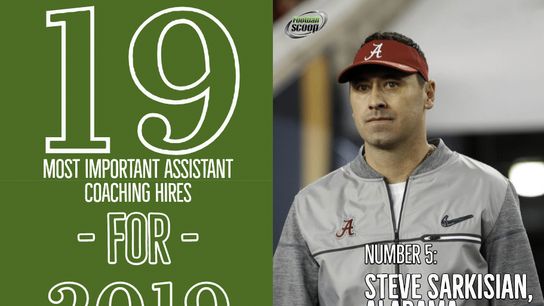Texas famously enjoyed a breakthrough season in 2023, but that season ended before it could have because of a deficiency that was a problem until the bitter end. As in, literally the last snap of the entire season.
The Longhorns finished 120th in red zone touchdown percentage last season. Texas moved into the red area 61 times across 14 games, which tied (ironically, with Texas A&M and Texas State) for 12th nationally. But they converted only 31 chances into six points, which tied for 48th in raw numbers but was 13th from the bottom in percentage -- 120th out of 133. This, after ranking fourth in 2022.
Texas accomplished that abysmal number despite sporting a lineup sent three wide receivers, a tight end and two running backs to the NFL draft last spring, and returns a quarterback and a left tackle anticipated to go highly in next spring's draft.
How is that possible, Steve Sarkisian?
"I think that's probably the byproduct of a few things," he said at SEC media days Wednesday. "Any time you lose a top-10 (draft pick) at running back, that's probably going to affect your play. We lost Roschon Johnson, too, who was a great player. Every year is different. We missed some opportunities that I thought we could have taken advantage of. The play-caller, me, probably tried too hard."
Texas's losses to Oklahoma and Washington came by four and six points apiece. Texas came away empty in red zone trips at one point in both contest.
Against Oklahoma, Texas was staked with a 1st-and-goal at the 1-yard line trailing 27-20 early in the fourth quarter, but failed to move the required three feet in four chances.
Texas eventually took a 30-27 lead, but lost the game 34-30 on a Sooner touchdown pass with 15 seconds remaining. Oklahoma also snared an interception at its own goal line in the first quarter of the game.
"You just get back to the drawing board," Sarkisian said. "Every year you have places you want to work on. We've definitely done that. I think we've got enough versatility in our offense to be effective in the red area, and we're going to need to be. We work way too hard to get ourselves all the way down there, not to put the ball in the end zone."
The issues started before UT's annual midseason rivalry game, and extended long after. The national average was a shade above 60 percent in 2023; Texas finished below that number nine times in 14 games. Lowlights included 2-for-5 vs. Rice, 0-for-3 against Oklahoma; 2-for-5 vs. BYU; 1-for-4 in a double overtime survival of Kansas State; and a baffling 3-for-8 in an otherwise emphatic demolition of Texas Tech.
"Any time you don't score on the goal line, two groups get criticized," Sarkisian said. "One is the offensive line, two is the play-caller. Our offensive line takes a lot of pride in their work. Coach Flood does a great job. I thought we were a lot more effective in those situations wore on, later in the year, and it showed. We got a lot more creative."
Texas was a respectable 4-for-6 in the Sugar Bowl loss to Washington, but the two they missed were the most painful of the entire lot. Trailing 37-28 in the final two minutes, Texas couldn't convert a 3rd-and-4 at the Washington 7 and settled for a 25-yard field goal. After improbably getting the ball back and racing down the field, Texas's earlier failure to find pay dirt meant the Longhorns needed a touchdown upon securing a 1st-and-10 at the Husky 12 with 15 seconds to play.
Texas got four shots from that point, every one of them unsuccessful. There, failure can be placed at the feet of three different Longhorns who trekked to Dallas on Wednesday. Sarkisian's play calls did not put Washington's defenders into compromise or conflict. Quarterback Quinn Ewers fired incomplete to Adonai Mitchell. And left tackle Kelvin Banks surrendered a pressure on third down that could have ended the game.
The simplest way for any team to improve in the red zone is just bulldoze the ball across the goal line -- or at least give the appearance it has the ability to do so -- and there Sarkisian credited his continuity up front as a key to improvement.
"Kelvin's no longer the young freshman, sophomore left tackle," Sarkisian said. "He's going into his third year and he exemplifies everything you want a Longhorn to be."
To his right, Texas returns left guard Hayden Conner (27 career starts), center Jake Majors (41 starts), right guards DJ Campbell and Cole Hutson (27 combined starts) and right tackle Cameron Williams (a new starter, but a third-year player).
Texas is one of four teams nationally to return both coordinators, its strength coach and its starting quarterback for the past three seasons. Sarkisian said Wednesday his depth at wide receiver is stronger than it's ever been, and the running back room returns CJ Baxter, who started before Jonathan Brooks's emergence, and Jaydon Blue, who shined after Brook's November season-ending injury.
After a 5-7 debut three years ago -- “I’ll tell you this much — 5-7 in Austin, Texas, sucks" -- Texas has come a long way in a short time, a place where they're now weeks away from the SEC commanding genuine respect. One could say they've worked hard to move the entire program down to the red zone.
To get the program where he wants it to be, Sark's most urgent task is to put the football where he wants it to be -- across that thick, white line in front of the end zone.
